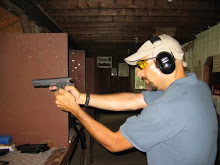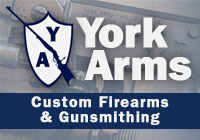Nomenclature.
Most rifle rounds are named in two parts: The number, which typically is derived from the diameter of the actual bullet, and the name, which is usually the company making the round or the person who wildcatted it first (wildcat means to take an existing caliber and change it - either by shortening the case, necking the case down further, or opening a necked case up for a larger bullet). Examples of this would be .223 Remington, .308 Winchester, ..257 Roberts, etc. Rifle rounds used in military applications are most often named using the diameter of the bullet and the length of the case in millimeters - hence a 7.62X51mm round has a diameter of 7.62mm (.308") and a case length of 51mm. Older rounds with a ##-## designation have the bullet diameter first and the weight of the blackpowder charge in grains - a .45-70 would have a 0.45" diameter bullet with 70 grains of powder behind it.
Acronyms.
BMG: Browning Machine Gun
H&H: Holland & Holland
NATO: North Atlantic Treaty Organization (modern military caliber)
SPC: Special Purpose Cartridge
WCF: Winchester CenterFire
WSM: Winchester Short Magnum
WSSM: Winchester Super Short Magnum
Common rifle rounds
As discussed previously, there are literally hundreds of calibers chambered for rifles. In the interest of not taking up pages upon pages by describing all of them, here are the "Top Ten" most popular rounds (limiting to 10 like with pistols). Calibers like .22LR or 9mm which are also handgun rounds will not be covered.
.223 Remington/5.56mm
.308 Win/7.62X51mm
.30-30 Winchester
.30-06 Springfield
7.62X39mm
7.62X54mmR
.375 H&H Magnum
7.92 X 57mm (a.k.a. 8mm Mauser)
.45-70 Government
.50 BMG
All of these rounds should be readily available at any gun store; all but .50 BMG should be available at most popular sporting goods chains that carry firearms and ammunition. The military cartridges can often be purchased as military surplus for much less than new ammunition, however it can often be corrosive, susceptible to misfires, or just plain old. Rifle ammunition is significantly more expensive than pistol ammunition - 7.62X39mm ammunition is the least expensive rifle cartridge out there as a rule (for new, non-corrosive ammo), and it runs between $5 and $7 for a box of 20 rounds. .50 BMG can run upwards of $4 a single round...
Rifle rounds are generally more specialized than pistol rounds - very little hunting is done with most handguns as a general rule, whereas rifles are used primarily for taking down wild game of varying size and speed. Larger calibers for dangerous game; more powerful rounds for longer-distance shooting; small, fast calibers for varmint hunting; even the diminutive .17 HMR has it's place in the hunting community for taking small fur-bearing animals with a minimum of damage to the pelt. While rifles offer far superior knock-down power when dealing with two-legged animals, they're rarely used given the danger of over-penetration. With larger, more powerful rounds available, a bullet can easily travel through multiple walls and other assorted objects. It's fine for taking down a deer out in the woods, but when you've got neighbors on three sides of you, a .300 Super Magnum with a mile-long range is going to make you mighty unpopular should you ventilate your neighbor's house with it...
Miscellany
- Both 5.56X45mm/.223 Remington and 7.62X51mm/.308 Winchester are oddballs in that they are the same size round, but the military designations are loaded to different pressures than their commercial counterparts. Guns chambered in .308 Winchester can fire either round; guns chambered in 7.62X51mm should only fire that particular designation. It's precisely the reverse for 5.56X45mm - the .223 Remington commercial variant is lower pressure, so a rifle chambered for 5.56mm can fire both. This can lead to no end of consternation when buying ammunition for these rifles, and most often leads to folks opting for the militarily chambered arms whenever possible. Thanks to New Jovian Thunderbolt for the correction on this matter.
- Some rounds are irrevocably linked to certain firearms - the 7.62X39mm, for example, is the round used by the AK-47 and the SKS rifles. The .30-30 is a lever-action round, most commonly found in Winchester and Marlin lever guns. .30-06 is an old military round most famously chambered in the M1 Garand (but also in the Browning Automatic Rifle [BAR] made most famous by Bonnie & Clyde).
- Some rounds are "belted" - there is additional metal around the base of the case to assist in headspacing the rimless round.
- Short and Super Short Magnum calibers utilize a wider case that is shorter overall to maximize the powder loaded while maintaining a shorter round overall. This allows a firearm chambered in a Short Magnum caliber to have a shorter action than a traditional long-action firearm (comparing a .308 action to a .30-06, for instance).
- Rifle (and handgun, for that matter) calibers are limited to 0.50" or less diameter size under the National Firearms Act of 1934. Any firearm with a rifled barrel cannot chamber a round larger than a half-inch or it is considered a "Destructive Device" by the BATFE.
- Some ammunition, typically older military surplus ammo, has corrosive primers - these are primers that contain certain salts for long-term stability, and when fired, the salts get deposited on the barrel and action of the firearm being used. If the firearm is cleaned immediately with warm water and/or ammonia, the salts are neutralized and the firearm is fine. Forgetting to clean right away leads to very bad things...
Thus concludes our (exceptionally short and barely skimming the surface) dissertation on rifle rounds. Obviously, there is a lot of material that was not covered - how the rounds are necked; why some are straight-walled and others not; why there are multiple, seemingly redundant calibers; there are many subjects simply not broached in this essay. This is intended to be a brief, skimming overview of common rifle rounds currently available, not a treatise on every long arm round ever produced.
What other information would be good for a new shooter to know about rifle ammunition?
That is all.







6 comments:
Weight of the various bullets... e.g. .308 can run from 135 gr to 180gr. .223 from 50gr to 79gr. Also difference between FMJ, Ball, hollow point and boat tail hollow point... And the impact on bullet trajectory...
Of course that also leads to twists in the barrel to match the bullet weight or vice versa... e.g. .223 1/12 for a 50gr vs. 1/7 for a 79gr.
just a couple of 'minor' things :-)
Good overview though!
You sure you got that right? Rifle that fires .308 can also fire 7.62, but a gun designated 7.62 shouldn't fire .308.
And the opposite for the littler cousin. A rifle that fires .223 shouldn't use 5.56, but a 5.56 could use .223. Or at least that was what I remember. I am not too sure of this second one as I am not the owner of or shopping for this size gun/caliber.
That was the rule of thumb, at least.
Here is what I am sure of. You don't want to fire commercial .308 in a converted 7.62 surplus Navy Garand. My gunsmith said hell no.
NJT has it right. The 7.62x51mmNATO is loaded to a lower pressure than .308 Winchester. Hence using hot .308 Winchester rounds in a gun chambered for 7.62 NATO can be a bad idea.
Also, while you're generally correct about rifles with a caliber of over .50 being destructive devices, there are exceptions made for cartridges that are deemed to be "sporting." Hence, the .600 Nitro Express (a cartridge designed for elephant hunting) is not considered a destructive device.
I'd add that the .30-06 was originally made for the fabled Springfield M1903 bolt-action rifle. It was then used for the BAR, the M1 Garand, and Browning's M1917/M1919 series of light machine guns. Among others. It's still one of the most popular big-game rounds in the world.
These who are interested in imported long arms will probably see a lot of rifles in .303 caliber, the British equivalent of the .30-06.
Old NFO,
That's more "Caliber 202" material - I figure we can discuss bullet weights and shapes in the next series once the new shooter has had time to digest the basics.
T-Bolt,
Thanks for the correction. I had assumed - and we all know what happens when you assume - that it was the same for both rounds, that the military round was more powerful.
With that correction in mind, I guess I can shoot that surplus 7.62X51mm in my VEPR!
Robert,
Thanks for the corroboration on the .308/7.62X51mm. I have a VEPR chambered in .308 Win, and picked up some 7.62X51mm surplus a while back, then got confused (what else is new) and decided to leave it in the ammo locker.
Looks like I've got some plinkin' ammo now!
As far as the sporting rounds, I figured the exceptions were few enough to leave for later, but thanks for mentioning it.
A rifle can be chambered for a greater than .50 diameter cartridge if it is either not designed to use fixed ammunition or if it has been judged "suitable for sporting purposes" by the ATF
Post a Comment